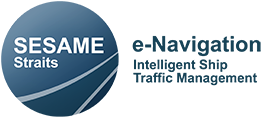
1. General Information
- Name of testbed: SESAME Straits project
- Location of testbed: Straits of Malacca and Singapore
- Period: 2014-2017
- Status: Active
- Contact: Todd Schuett, Project Manager,
- Website: www.straits-stms.com
- Organizations: Kongsberg Norcontrol (owner), Norwegian Coastal Administration (Kystverket), Kongsberg Maritime, Kongsberg Seatex, Navtor, Marintek, University College of Southeast Norway
- Funding program & budget: Norwegian Research Council – approx. NOK 23M
2. Executive summary
The primary objective of the SESAME Straits e-Navigation testbed project is to develop and validate a new and ground-breaking concept for a Ship Traffic Management System (STMS) based on shared situation awareness and cooperative decision making between ship’s bridge team and shore personnel.
The project intends to revolutionize traditional Vessel Traffic Services (VTS) which today only provide monitoring and advisory services locally. The innovation of the proposed system is to provide a cooperative platform that will be available for tactical as well strategic planning for several days in advance of arrival. This includes new operational services for a regional Maritime Service Portfolio (MSP), such as:
- Just in time arrival advice: Up to several days before the ship’s arrival.
- Optimal transit speed: To reduce ship’s bunkers and lower GHG emissions.
- Efficient traffic flow through narrow and restricted under keel clearance waterways.
- Better utilization of port resources such as anchorages, berths, pilots, etc.
The concrete results of the project are new/enhanced ship and shore systems, which for the purposes of this project, shall be considered as a single integrated system used in the ship-shore test-bed. This system provides the following levels of innovation:
– Prediction and hot-spot detection. Introducing advanced data fusion techniques of real-time and non-real-time data sources; this will enable enhanced environmental, safety and security hot-spot prediction on strategic and tactical levels based on historical and present-time traffic information. This will be a new component in the VTS.
– Cooperative decision support and shared situation awareness. New methods will be developed to enable shared decision making between ship and shore for optimizing vessel sailing plans. This will be linked to prediction tools to provide what-if functionality for the different sailing options.
– Ship-shore digital communication. This is based on the emerging higher capacity VHF Data Exchange System (VDES) and new data standards linked to the e-Navigation Common Maritime Data Structure and the S-100 framework for data exchange.
Simulator and assessment tools are off-line tools for analysis of traffic management strategies and will be configurable for different geographic areas and traffic situations. It will also be able to use existing traffic patterns as SESAME Straits baseline to create benchmark values. The tools represent an entirely new way of doing standardised safety and efficiency assessments of a given waterway as it will employ behavioural and stochastic modelling in addition to the methods used today.
3. Tested services
- Transmission of planned route from ship to shore
- Optimization of route on shore and transmission to ship
- Just-in-time arrival slot electronic transmission shore to ship
4. Testbed Information
The type of user group/s involved in the test
- Shipboard users
- Shore-based users
Details of e-navigation gap/s considered for the testbed
- Effective and robust data communication and data transfer
- Systems and equipment
- Traffic monitoring; and/or
The category of e-navigation gap/s considered in the testbed
- Technical
- Operational and/or
Details of e-navigation solution/s considered in the testbed :
- S4: Integration and presentation of available information in graphical displays received via communication equipment
- S9: Improved Communication of VTS Service Portfolio
The category of e-navigation solution/s considered in the testbed
- Technical
- Operational and/or
Links to similar / relevant testbeds (if any)
- EfficiencSea2,
- STM Validation
5. Testbed methodology
To be completed after the conclusion of the SESAME Straits Sea Trial.


